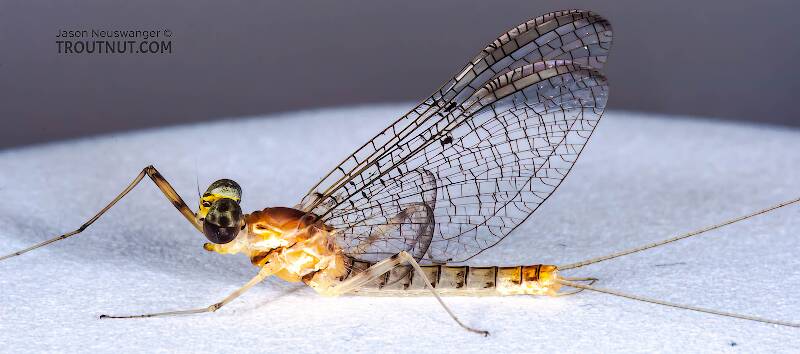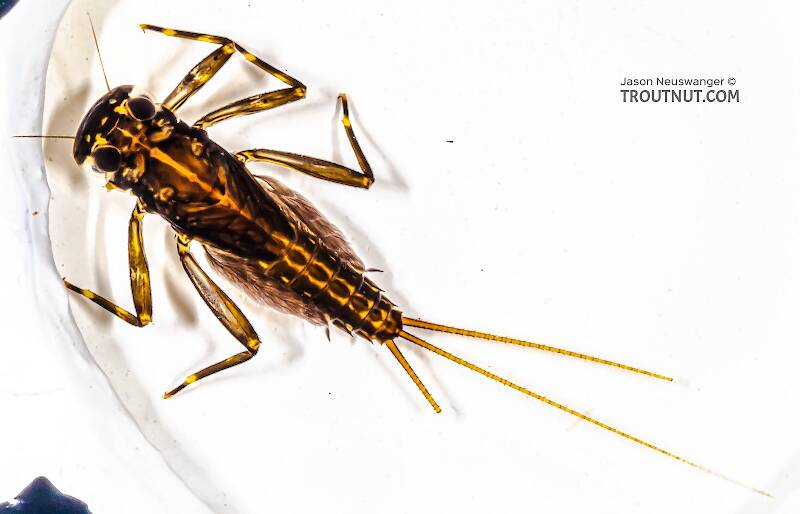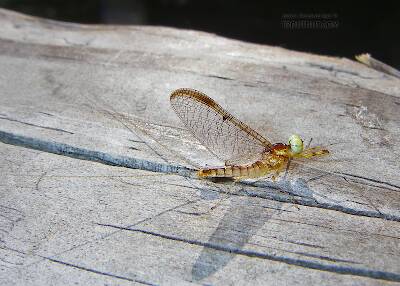
Salmonflies
Pteronarcys californica
The giant Salmonflies of the Western mountains are legendary for their proclivity to elicit consistent dry-fly action and ferocious strikes.


Mayfly Species Stenacron interpunctatum (Light Cahills)
Where & when
Stenacron interpunctatum emergence is quite sparse, but it can be important because there is so little competition on the water on late-season evenings.The best hatching in the East is in late June an early July, and in the Midwest this species peaks about a month later.
In 137 records from GBIF, adults of this species have mostly been collected during June (23%), July (21%), May (19%), August (19%), September (7%), and April (6%).
In 128 records from GBIF, this species has been collected at elevations ranging from 3 to 9236 ft, with an average (median) of 2920 ft.
Species Range
Hatching behavior
Spinner behavior
Time of day: Twilight or after dark; may be earlier on cloudy days
Habitat: Riffles
The females oviposit while laying on the water.
Nymph biology
Current speed: Medium to fast
Substrate: Gravel, detritus
Environmental tolerance: Tolerant of warm temperatures, but not pollution
Physical description
Most physical descriptions on Troutnut are direct or slightly edited quotes from the original scientific sources describing or updating the species, although there may be errors in copying them to this website. Such descriptions aren't always definitive, because species often turn out to be more variable than the original describers observed. In some cases, only a single specimen was described! However, they are useful starting points.
Male Spinner
Wing length: 7.5-11 mm
A species of Stenacron interpunctatum group, having a black dash in fore wing near bulla; black markings on face and pronotum; basal fore tarsal joint about 1/3 of second; no dark spiracular markings; no median dark band on hind femur.
Head yellowish green; black dash below each antenna and black markings on carina. Ocelli black-ringed at base; black line through eye; antennal filament blackish. Pronotum yellowish, a black lateral streak on each side. Mesonotum brownish. Pleura and sternum yellowish, without distinct dark markings. Legs yellowish or greenish yellow; femora of fore and middle legs with median and apical black bands, hind femur black apically, not in middle. Basal joint of fore tarsus about 1/3 as long as the second. Wings hyaline; longitudinal veins yellowish; cross veins in anterior half of fore wing black in costal margin, dark brown behind this region. Say states, “wings on the anterior margin greenish.” Cross veins in basal costal, subcostal and radial spaces margined with black; at bulla, 2 in the radial space with a black dash connecting them at about the center. Cross veins behind costal margin in apical portion beyond disc tend to be arranged in series. At apex of wing, marginal intercalaries in 2nd and 3rd spaces often somewhat darker and more thickened than others. Veins in anal region of fore wing and in most of hind wing paler. Outer margin of hind wing with narrow but distinct black border, the marginal intercalaries also dark in this area. Stigmatic area with reddish tinge, according to Dr. McDunnough.
Abdominal segments 1-7 hyaline whitish; posterior margins of tergites narrowly blackish; no dark spiracular dots. Segments 8-10 opaque; tergites ‘“more or less obviously ferruginous” (Say). Genitalia of interpunctatum type (see fig. 91, S.canadense (now Stenacron interpunctatum); a pair of stout median spines; shorter spines on outer margin of penes below the expanded upper portion. Tails immaculate, according to Say; pale whitish.
Described as S. canadense
Body length 8-9mm, wing length 9mm
A dark reddish brown species of Stenacron interpunctatum group; black markings on face and pronotum, and oblique black streaks on pleura; abdominal tergites largely dark red-brown.
Head dark red-brown; a black band on face below each antenna, but not continuous across face; a dark spot on median carina; a small black dot near inner margin of eye, posterior margin of head black, the dark line thickest at median line. Pronotum brown; median line, posterior margin at middle area, and oblique lateral streaks, black. Mesonotum deep brown; scutellum narrowly tipped with pale yellowish. A faint purplish red streak anterior to wing root. Pleura yellowish, sutures dark red-brown; an oblique prominent black streak below each wing root, anterior to middle and hind legs. Between base of fore and middle leg, a darker brown area. Sternum red-brown, a blackish area laterally on mesosternum, below base of middle leg. Femora greenish yellow, fore femur slightly tinged with red-brown; median and apical black bands on all femora. Fore tibia yellowish brown, black at apex; may be very slightly longer than femur; tarsus smoky brown, basal joint more than 1/3 but less than 1/2 length of second. Middle and hind tibiae and tarsi rather yellowish; claws and tarsal joinings brownish, tarsi may be faintly smoky. Costo-apical area of fore wing tinged with brownish, with a faint reddish tinge at stigma. Longitudinal veins of costal margin yellowish brown; others black-brown; cross veins black, those of costal margin somewhat thickened; cross veins basal of bulla narrowly dark-margined, in radial space more widely margined; at bulla 3 widely margined veins are usually connected by a black dash. Hind wing narrowly blackish on outer margin.
Abdominal tergites 1-9 largely blackish brown; mid-dorsal line and posterior margin darker; pale submedian streaks, lateral margins, and antero-lateral triangles remain; these areas yellowish. Extent of pale submedian marks apparently somewhat variable. No dark spiracular dots apart from general dark areas. Tergite 10 somewhat paler, reddish brown. Sternites 1-7 yellowish, posterior margins faintly and narrowly pale brown; some specimens show some brownish shading except on lateral margins, but no distinct dark mid-dorsal band. Forceps smoky; penes pale-brown; of the interpunctatum type (see fig. 91). Tails pale yellowish white on basal half, dark smoky apically; joinings dark brown.
Described as S. conjunctum
Body length 8 mm, wing length 9 mm
A yellowish species of the Stenacron interpunctatum group; black marks on face and pronotum; spiracular dots faint, diffuse, as is median band of hind femur.
Head yellowish; black spot on median carina; one at inner corner of eye; black dash below antenna. Antennal filament dusky, tip paler. A small black dot near each eye, on vertex, halfway to posterior margin; reddish shading near posterior margin. Pronotum yellowish; an oblique black streak on each side. No dark mark at postero-lateral angle; often a small black dot on posterior margin at median line. Mesonotum reddish brown; scutellum pale, the lateral areas anterior to it darker brown; faint darker median and anterior pencilings. Pleura yellowish; a rather prominent purplish black oblique streak below roots of fore and hind wings, anterior to bases of middle and hind legs; greyish shading above leg bases. Sternum yellowish. Legs yellowish, femora greenish yellow; black median and apical bands on fore and middle femora, median band on hind leg fainter, rather diffuse, may even be wanting. Longitudinal black pencilings on all femora. Fore tibia black at apex; other tibiae narrowly dark brown apically; all tarsi faintly smoky. Basal joint of fore tarsus slightly more than 1/3, but distinctly less than 1/2 the length of second. Wings hyaline; cross veins dark-margined as in S. interpunctatum; a black dash at bulla in radial space. Costa, subcosta and radius yellow in basal two-thirds, brownish apically; other longitudinal veins dark brown, cross veins black. Apical portion of costal margin tinged with yellowish brown, extending around tip of wing. 3rd and 4th marginal intercalaries at wing tip thickened, black. Outer margin of hind wing dusky.
Abdominal segments 2-8 semi-hyaline, yellowish white. Posterior margins of tergites narrowly purplish black. Spiracular dots small, diffuse, not prominent as in S. frontale (now a synonym of Stenacron interpunctatum); may be absent on basal segments. Occasional specimens have very light greyish shading medially and laterally on basal tergites, but much less distinct, than in S. proximum (now a synonym for Stenacron interpunctatum). Segments 9 and 10 opaque; tergites usually rather dark red-brown, posterior margin of 10 yellowish. Sternites yellowish. Forceps yellowish, penes flesh-colored, with the inner apical portion rather elevated, as in interpunctatum. Tails pale whitish, joinings narrowly reddish at base, brownish apically.
Described as S. frontale
Body length 8 mm, wing length 9 mm
A pale species of Stenacron interpunctatum group; black markings on face and pronotum black streaks on pleura, dark spiracular dots.
Head yellowish; a black spot under each antenna, another on median carina, and a smaller dot near inner margin of each eye. Vertex somewhat reddish brown; posterior margin darker, apparently a dark spot on each side. Pronotum yellowish to light brown; an oblique black streak on each side; a small dark spot often present on postero-lateral corner. Mesonotum dark reddish brown; scutellum yellowish. Pleura yellowish; two oblique black streaks, one below root of each wing, anterior to bases of middle and hind legs. Sternum yellowish. Femora yellowish, each with median and apical blackish bands. Tibiae whitish; fore tibia blackish at apex, very slightly longer than femur. Fore tarsus greyish white, joinings slightly darker; basal joint almost 1/2 length of second. Tarsi on middle and hind legs pale, smoky at tips, joinings smoky. Wings hyaline; apical portion of costal margin brownish. Longitudinal veins brown, cross veins black. A few cross veins in costal and radial areas narrowly black-margined; under the bulla, two or three are more broadly margined, but with no dark bar connecting them. Wings rather long and narrow; about 6 basal costal cross veins and 13 or 14 beyond bulla.
Abdominal segments 1-7 whitish, hyaline; posterior margins of tergites rather widely blackish brown; distinct large dark spiracular dots. Tergites 8-10 reddish brown, sternites yellowish. Forceps pale; penes rather flesh-colored; apical portion of penes less elevated at inner margin than in S. interpunctatum, so that these structures appear shorter and more rounded (frontale (now a synonym of S. interpunctatum) type; see fig. 91). Tails pale at base, tip pale smoky; joinings very faintly darker.
Described as S. heterotarsale
Body length 9 mm, wing length 11 mm
A species of the Stenacron interpunctatum group; basal fore tarsal joint about half the length of second; no dark markings on face or pronotum; no spiracular dots; no median band on hind femur; abdomen pale dorsally.
Eyes light green, in living insect. Head pale yellow; anterior and posterior margins semi-hyaline. Brown shading on vertex, “deepest in a triangular patch covering posterior area, becoming almost purple-black” (McD.). Pronotum light yellow, without. dark markings. Mesonotum largely brown; posterior portion pale hyaline yellowish; scutellum “tipped with opaque ochreous.” Metanotum light yellowish ochre. Pleura yellowish; anterior to wing roots is a reddish streak; deeper shading between fore and middle legs. Sternum yellowish. Legs light yellow, fore femur more distinctly yellow; blackish median and apical bands on fore and middle femora, distinct on fore leg but faint on middle femur; no median band on hind femur, apex blackish. Tip of fore tibia and all claws smoky. Basal joint of fore tarsus about 1/2 the length of the second. Wings much as in interpunctatum, except that the stigmatic area of fore wing is shaded with light amber and lacks the reddish tinge of that species.
Abdominal segments 2-7 hyaline, yellowish white; posterior margins of tergites with a fine blackish band. No dark spiracular dots. Segments 8-10 opaque; tergites shaded with ruddy brown, narrowly in median area of 8, on all of 9 and 10; lateral area of 8 pale yellowish; 8 and 9 with blackish posterior margins. Sternites wholly pale; 8 and 9 almost alabaster white. Genitalia very similar to interpunctatum, “but appear to have the latero-apical margin of the penes somewhat more oblique than in this species” (McD.). Tails pale, very faintly darker at joinings.
Described as S. majus
Body length 9.5-10.5 mm, wing length 11 mm
A large rather pale species of Stenacron interpunctatum group; black marks on face and pronotum, wide oblique pleural markings; black spiracular dots; median band on hind femur.
Head yellowish; a black dash below antenna; black spot on median carina, and very small dark spot at inner margin of each eye. Two short black marks on each side of vertex near eye, small median reddish dot; dusky shading near posterior margin. Pronotum yellowish; posterior margin blackish in median area, connected at each end to the wide black lateral streak; an incomplete black longitudinal streak above fore coxa, appearing as a black spot at postero-lateral corner of pronotum and black streak anteriorly. Mesonotum dark red-brown; scutellum and postero-lateral margins yellowish; anterior to scutellum, a darker brown area. On each side of mesonotum anteriorly, a longitudinal black stripe. Pleura yellowish; a wide oblique purplish black streak below roots of fore and hind wings, anterior to middle and hind legs. Purplish black shading posterior to middle and hind coxae, and wide purplish shading anterior to hind coxa. Antero-lateral and postero-lateral areas of metanotum with considerable blackish shading. Sternum yellow.
Legs yellowish white, femora deeper yellow. Purplish black median and apical bands on all femora, median band on hind femur sometimes rather faint. Fore tibia blackish at apex; basal tarsal joint fully 1/2 the length of the second. Tibiae of middle and hind legs sometimes faintly dusky in middle area; tarsi pale, joinings scarcely darkened; claws dusky. Wings hyaline; longitudinal veins amber yellow, cross veins black; cross veins margined as usual, but near bulla those in costal space are thickened near costa. Black dash at bulla, on 1, 2 or 3 cross veins. Costal margin amber-tinged, faintly at base, more deeply apically, continuing around tip of wing. Outer margin of hind wing dusky.
Abdominal segments 1-7 hyaline, pale yellowish white; posterior margins of tergites purplish black, rather wider on basal than on apical segments; middle sternites may be faintly dark-shaded posteriorly at median line. Basal tergites sometimes with faint greyish streak on mid-dorsal line, and with faint lateral shading. Spiracular dots large, black, prominent; at or near the ends of the dark bands. Segments 8-10 opaque; 8 and 10 largely yellow, tergite 9 distinctly reddish. Forceps pale, apical joinings dusky; penes flesh-colored, quite similar in structure to those of S. frontale (now a synonym of Stenacron interpunctatum). Tails pale whitish, narrowly brown at joinings. Female similar to male but paler, with usual sex differences.
Described as S. ohioense
Body length 8-10 mm, wing length 9-10 mm
A rather dark species of Stenacron interpunctatum group; basal joint of fore tarsus about 1/2 length of second; spiracular dots distinct; tails darker at joinings.
Head yellowish red; continuous black transverse line across face from inner margin of eye, below antenna. Antennal filament dusky, tip paler. A black spot on each side of vertex, and submedian black streaks continued backward to meet the blackish posterior margin. Pronotum reddish brown in median area, yellowish laterally; anterior and posterior margins black, the ends of the latter continuous with the oblique black streaks on each side; just before the posterior margin, several other shorter blackish transverse marks. A black mark in postero-lateral corner. Mesonotum dark red-brown; a median strip, and a narrow streak along lateral margin, brighter red. Median area at anterior and posterior portions distinctly blackish, this area taking the form of a dark triangle anterior to scutellum, which is not paler than areas around it. Metanotum dark red-brown, its central area with a large triangle outlined prominently in black, the base extending across middle of segment, its apex on anterior margin. Pleura yellowish red; a short purplish black mark anterior to middle coxa, faint dark marks at base of hind coxa. Sternum reddish yellow.
Fore legs greenish yellow with slight smoky tinge. Median and apical blackish femoral bands. Tips of tibiae blackish; tarsal joinings narrowly dark brown. Basal joint of fore tarsus almost or fully 1/2 as long as second joint. Middle and hind legs yellowish white; apical purplish black femoral bands prominent, median bands fainter; tips of tibiae and tarsal joinings brownish. All claws dusky; faint blackish longitudinal pencilings on all femora. Wings hyaline; costa, subcosta and radius yellowish brown, other longitudinal veins red-brown, cross veins slightly darker; all veins of anal region of fore wing and in hind wing finer and slightly paler. Cross veins in costal border dark-margined as usual; two or three radial veins at bulla more widely margined, often (but not always) connected by black dash. Apical portion of costal margin tinged with greenish amber, becoming brownish around tip of wing. Outer margin of hind wing narrowly purplish brown.
Abdominal segments 1-6, and tergite 7, semi-hyaline yellowish white; tergites 1-5 rather heavily shaded with purplish black in median area, the median geminate streak and posterior margins deeper blackish. Lateral margins and somewhat crescentic submedian streaks remain pale. Dark shading less extensive on 6; confined to median line and posterior margin, on 7. Sternites very faintly brownish at middle of posterior margins. Segments 8-10, and sternite 7, opaque, deep yellowish, tergites sometimes with a reddish tinge. Posterior margins of 8 and 10, and median line of 8, faintly dusky. Distinct black spiracular dots on segments 2-8. Forceps dusky; penes pale yellowish, very similar in structure to S. frontale (Now a synonym of S. interpunctatum). Tails pale yellowish basally, joinings narrowly dark brown; apical portions smoky brown, joinings not distinct. Female paler but with similar dark markings.
Described as S. proximum
Body length 9-9.5 mm, wing length 10 mm
A yellowish species of Stenacron interpunctatum group; black dots on face, black streaks on pronotum, also oblique black streaks on pleura; spiracular dots diffuse, usually present; greyish median streak on tergites 1-4.
Head yellowish; a black spot below each antenna, a very small dark spot near inner margin of each eye; usually no dark spot on carina, which is whitish. Antennal filament dusky, tips paler. Reddish shading at bases of ocelli, sometimes faintly near posterior margin of head; two short black streaks near each eye, on vertex, also a very small reddish median dot. Pronotum yellowish; an oblique black lateral streak quite prominent; a small black dot on posterior margin at median line, sometimes another anterior to this. Mesonotum yellowish, sometimes tinged with reddish; median area may be slightly darker. Anterior to wing roots, a purplish black streak, along margin of mesonotum. Pleura and sternum similar in color to mesonotum; a prominent purplish black oblique streak below roots of fore and hind wings, anterior to middle and hind legs, and between this and base of middle leg, another shorter dark streak (in some specimens, these streaks are rather faint). Legs yellowish, with faint greenish tinge; median and apical black bands prominent on fore and middle femora, median band on hind femur diffuse, may be wanting; longitudinal black pencilings on all femora. Tip of fore tibia black; tarsus faintly smoky; basal joint fully 1/2 the length of the second. All tarsal joinings faintly darkened. Wings hyaline; costa, subcosta and radius yellowish brown, other longitudinal veins darker brown, cross veins black; those of basal spaces in costal margin narrowly dark-margined. At bulla, a short black dash, often on one or two cross veins only. Apical portion of costal margin tinged with yellowish or greenish yellow. Outer margin of hind wing dusky.
Abdominal segment 1-7 yellowish, often with greenish tinge (whitish, in alcohol); posterior margins of tergites purplish black. Diffuse blackish spiracular dots are usually present, not very prominent; may be wanting on very pale specimens. Posterior margins of sternites may be faintly grey-tinged in median area. Mid-dorsal line of tergites 1-4, sometimes also 6-8, with a distinct greyish streak, may appear geminate; on basal tergites also, faint lateral greyish tinges may be present. Segments 8-10 opaque, deeper yellow, may be tinged with reddish dorsally; traces of grey shading in spiracular areas (at ends of dark posterior bands). Genitalia very similar to interpunctatum; forceps yellowish, the penes flesh-colored. Tails yellowish at base, often becoming dusky in middle and apical portions; joinings faintly darker.
Specimens of the Mayfly Species Stenacron interpunctatum
1 Female Dun

1 Male Spinner
1 Nymph
1 Streamside Picture of Stenacron interpunctatum Mayflies:
Start a Discussion of Stenacron interpunctatum
References
- Arbona, Fred Jr. 1989. Mayflies, the Angler, and the Trout. Nick Lyons Books.
- Caucci, Al and Nastasi, Bob. 2004. Hatches II. The Lyons Press.
- Knopp, Malcolm and Robert Cormier. 1997. Mayflies: An Angler's Study of Trout Water Ephemeroptera . The Lyons Press.
- Leonard, Justin W. and Fannie A. Leonard. 1962. Mayflies of Michigan Trout Streams. Cranbrook Institute of Science.
- Needham, James G., Jay R. Traver, and Yin-Chi Hsu. 1935. The Biology of Mayflies. Comstock Publishing Company, Inc.
- Schwiebert, Ernest G. 1955. Matching the Hatch. MacMillan Publishing Company.
- Swisher, Doug and Carl Richards. 2000. Selective Trout. The Lyons Press.
Mayfly Species Stenacron interpunctatum (Light Cahills)
Species Range
Common Names
Resources
- NatureServe
- Integrated Taxonomic Information System
- Global Biodiversity Information Facility
- Described by Say (1839)




